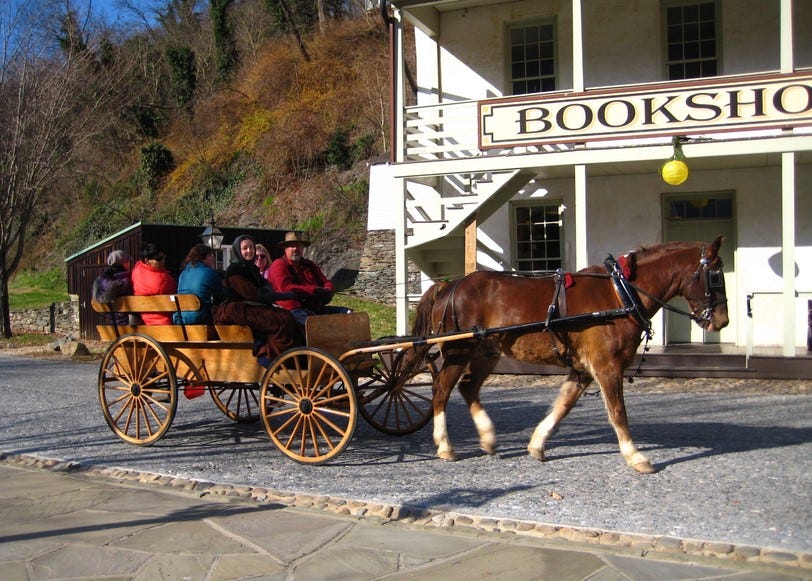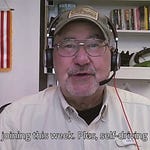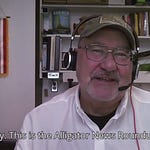Medical - Leukemia
One day at a time. I remain above-grade and vertical, and the lab work shows I remain among the extant. My health seems fine. It’s deceptive, I know, but I appear to be functional.
Don’t Forget the Merch
Send your college-bound child back to school with the Alligator Wrestling Travel Mug. Order the Wine Tumbler for yourself after he/she is out of the house.
And imagine how impressive your end-of-summer dinner party will be with a full set of ceramic mugs featuring The Big Leuk!
Watermark Books
And our good friends at Watermark Books in Wichita continue to stock Alligator Wrestling in the Cancer Ward for you. Order in person or online and show your appreciation for their distinguished literary cooperation.
If you have not been in their cafe, perhaps it’s time you should branch out. Try their scones; or a custom sandwich with names like “Great Expectations” or “The Great Gatsby.”
It offers an ambiance not to be missed!
Rotary Club Appearance
The Derby Rotary has invited me to speak this week (probably because they have never heard me speak before, and perhaps don’t know anyone who has) and I am looking forward to meeting with that assemblage of movers and shakers on Friday. It is very good of them to invite me! It should be fun!
Rambling Speculations
Disguised as a Daily Devotional
Parallel Correction Lines (Psalm 103:12)
During a 36-year stint with a Fortune 500 communication technology company, I managed to back myself into a position as a regional sales manager selling emergency communications services to local and state governments. It was an easy way to make large wake-up headlines if one of our products malfunctioned (like delivering incorrect data on a live 9-1-1 call, or providing call routing information that sent the call to the wrong police answering station).
Most of my peers thought I was nuts to take this job, and they may have had a point.
In the early 1990s, due to technological advances and regulatory changes in the telephone industry, most county governments across my territory (Kansas to Texas and Missouri to Louisiana) developed rural addressing. It is tough for an ambulance to find “Route 3, Box 12,” but something like “12861 SW 30th Road” is a piece of cake if you know the map.
Consider that many ambulance drivers are not long-term county residents; many are second-wage-earners who have made the EMT certification but didn’t go to high school there, and thus have no idea where the local unmapped “Whiskey Pass,” or “Beer Belly Road” might be.
I learned a whole new discipline of rural mapping: Cardinal directions, odd/even addressing schemes, physical lot frontages, 3-mile limits, and many other arcane concepts. The Parallel Correction Line was my favorite.
One day I found myself with my co-worker on customer calls in Texas. He insisted we use ground transportation to travel from western Texas to Shreveport, our next appointment, a mere 8-hour drive in a rented Crown Vic.
On a rural highway in the flatlands, traveling south to north, with wide visibility and a 360° view of no terrain of any interest whatsoever, I negotiated a wide, gentle turn which took us 1/8 mile to the right, then straightened out north again. There was no obvious reason for the swerve in the road.
“You know what that was, don’t you?” I asked.
“What?”
“A Parallel Correction Line.”
He turned to look at me from the passenger seat. “What are you talking about?”
“That curve we just went through. Didn’t you notice it?”
“Sure. It was just a curve. Every highway’s got ‘em.”
“Of course, they do. But why that one? And why there?” I gestured to the landscape. “There’s no river, no gully, no mountain, no ranch headquarters, no Catholic Monastery, no reason at all to move the highway over.”
He thought this over. “But I’ve seen the same thing in other highways.” He looked at me again. “So why do you call it a Parallelo Gizmo?”
“Parallel Correction Line,” I corrected. “Okay, look,” I said. “As you move north on the earth’s surface from the equator to the North Pole, the meridians get closer together, right? It’s on every globe you’ve ever seen. They have to get closer together, so they all meet at the same point.”
“Yeah, just under the North Star. So?”
“But when a farmer in south Texas buys a square mile of land, he expects to get 640 acres, and he also expects every acre to be exactly the same size as an acre of farmland his brother might buy in North Dakota. But if the meridians get closer together the farther north you go, you either have to make the miles shorter and the acres smaller – which no one will accept – or you have to have fewer miles and fewer acres between the meridians.”
“Maybe I see the problem,” he said. “But this sounds like arithmetic. Is this arithmetic?”
I shook my head. “Don’t worry, if the County Engineer can figure it out, you can probably follow it.”
“Good point,” he agreed. “But what’s that got to do with the curvy road?”
“As you travel south to north in the U.S.,” I said, “every 15 miles there is a change. Every eight miles of east-west becomes seven miles of east-west. The highways, and the county gravel roads and everything else, could get closer together, but that would mean shortening a mile to less than 5,280 feet, which is a non-starter. So you simply use fewer miles between the meridians.”
“So the meridians are not as far apart.”
“Exactly. And of course, some roads are simply dead-ended because they are no longer needed. This allows a mile to remain a mile and an acre to remain an acre.”
He furrowed his brow and thought about it. “So that has to happen in every county, every 15 miles?”
“Yep, as you travel north. You can find it on most maps, if there is sufficient detail, and if the highway department decided to honor the scheme when they built the road.”
“What happens to the east-west roads?”
“Absolutely nothing. They are not headed for the north star. Duh.”
“So how come you know this?”
“Occupational hazard. I worked with a few counties in Kansas, and we had to deal with this. There, counties are nominally 30 miles tall and 30 miles wide. That’s only a guideline. Most are smaller in both directions because of rivers and valleys.”
“There are rivers and valleys in Kansas? Who knew?”
“And rattlesnake roundups,” I said, “but don’t get smart. There is only one county in Kansas - Butler - which is more than 30 miles tall, so it gets two Parallel Correction Lines.”
“Must be quite the tourist attraction.”
“Not so much, no. But it did present a problem for the county addressing team. They named one of them ‘Parallel Road,’ and then discovered there was a second one.”
“What did they call it?”
“Southwest 150th, of course, because it is 15 miles south of the one they named Parallel.”
He thought about it some more. “One more question,” he said. “Why are the counties in Kansas laid out 30-by-30?”
“For one, it’s a pretty square state, so they CAN lay them out that way. But the real reason is how fast a horse can travel.”
He looked at me. “A horse?”
I nodded. “When statehood was granted in 1861, they began to establish county governments. It was important that all their residents be able to get to the county seat and back home within a single day.”
“And they rode horses?”
“In the best case, yeah. A horse could pull the wagon about two miles per hour. A 15-mile trip took 8 hours.” I glanced at him. “If the county seat was theoretically in the center, you could get there and back in a 16-hour day. Figure an hour at the dry goods store, and you’re home by dark, if you left early enough.”
“You have taxed my brain,” he said. Then he had a sudden thought. “Who decided where the county seat went?”
I laughed out loud. “That, my friend, is a whole other subject. In western Kansas, it involved six-shooters and shotguns, and resulted in dead bodies.”
He stared at me, wondering if I was serious, then shook his head. “Wake me when we get to the Louisiana state line.”
In a few minutes, he was asleep as Texas rolled by outside the air-conditioned Ford.
Theological Contemplations
Psalm 103:12 As far as the east is from the west, so far hath he removed our transgressions from us.
Interesting that the Psalmist does not say, “as far as the north is from the south.” North to south has a specific measurement, which that old fellow writing the Psalm in 1000 BC would not have known. The distance is about 12,000 miles. But in the mercy of God, He removes our sins all the way from east to west.
You can theoretically (or actually, in the right aircraft) travel east as far as your re-fueler will take you, and you will still be going east. It is an infinite distance. Same for east to west.
But when you fly north, and cross the Pole, you will begin going south. Ask those fellows in the Strategic Air Command who, in the 1950s and later, regularly made training flights in their B-52s from Minot across the Pole and toward Soviet airspace. It wrought havoc with their nav aids, and put a lot of pressure on a 20-year-old navigator to plot their course.
But the distance from north to south is finite. Probably unknown to the Psalmist, the phrase “as far as the east is from the west” accurately portrays the boundless mercy of a loving God, who removes our transgressions to that infinite distance.
Mark this down for the reliability of Scripture.
America by the Numbers
Counties (and county equivalents) in the U.S.: 3,243
State with most counties: Texas (254)
State with fewest counties: Delaware (3)
Most populous county: Los Angeles County (California, 10 million residents)
Least populous county: Loving County (Texas, 170 residents)
Largest county land area: Yukon-Koyukuk Census Area (Alaska, 145,505 sq mi)
Smallest county land area: Kalawao County (Hawaii, 12 sq mi)
Verse for the Week
Psalm 103:12, of course. As far as the east is from the west, so far hath he removed our transgressions from us.
And a good thing He has done so, for which we can be - literally - eternally grateful.
Have a good week!
Curt

























Share this post